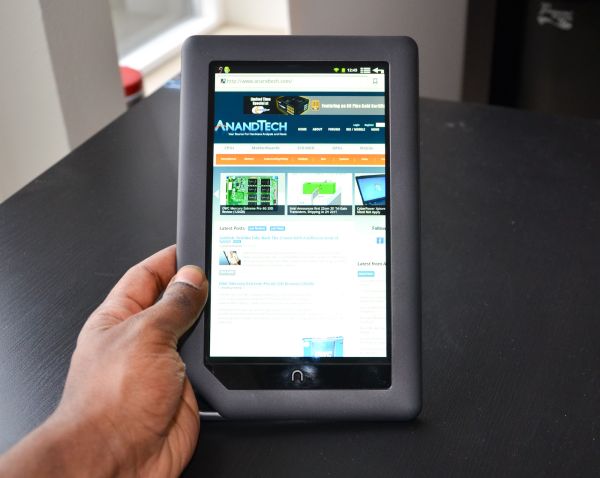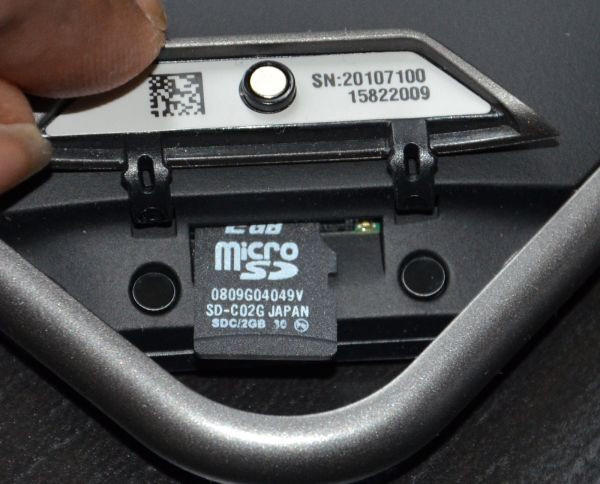Battle of the Budget Tablets - Nook Color vs. Galaxy Tab
by Vivek Gowri on May 25, 2011 12:52 AM ESTMeet the Contenders - Nook Color
The Nook Color is an interesting case. It’s technically an e-reader, and the included Android ROM never lets you forget that. But the spec-sheet says differently. A 7” 1024x600 IPS display, an OMAP3 SoC, and Android 2.2 for $249? Sounds like a budget tablet to me.
Gallery: Barnes & Noble Nook Color
On a hardware level, that’s basically what it is. As with most tablets, the front face is screen dominated, with a slightly larger-than-normal raised bezel and a stylised N beneath the display acting as the home button. The design of the Nook Color was handled by Yves Béhar and his team at fuseproject, one of the leading industrial design firms in the country.
You’d expect a device coming out of an elite design studio to have a very polished design, and the Nook Color definitely does. The design elements are very cohesive, with a final product that is at once attractive and very functional. The bezel is rendered in a metallic-look matte dark gray plastic, with a near-black rubberized back cover. Connecting the front and back faces is a matte silver rim around the four sides of the device, acting as a plastic band holding the device together. It’s a nice look, with slightly cooler shades of gray (probably 3-5% saturation of blue), and more importantly, the rounded edges make it very comfortable to hold, almost like a thin hardcover book. Almost makes you wonder if they meant for you to read books on it...

But the most notable industrial design feature of the Nook Color has to be the nook (for lack of better word) in the bottom left corner. It’s like a larger version of the through-holes you can find on some MP3 players and cell phones, but with basically no function beyond housing the microSD card slot (unless you really are planning on attaching a 7” tablet to a lanyard.) It’s more of a design quirk, one that adds a bit of character to the device, but an aesthetic element through and through. I’m a fan; it does a lot to break up the monotony that most tablets, especially ones with large bezels, suffer from while also making an amusing play on the Nook’s name.
The buttons and ports are built into the silver colored band, with the power button on the left side near the top, and the volume buttons near the top on the right side. The headphone jack is on the top and the microUSB on the bottom, as God intended them. The microSD card slot is built into the edge of the “nook” on the backside, under a flap bearing the Nook logo.
Overall, the Nook Color is bigger and heavier than the Galaxy, but that gives it a more significant feel in hand, and it definitely feels more durable and rugged than most of the other tablets out there. This is a combination of the larger bezel, the rubberized back, and the high quality matte plastic, and a welcome one. It’s a $250 device that really doesn’t look or feel like it.
Unfortunately, the spec sheet sheds some light on why it’s so much cheaper than the Galaxy. Let’s start with the CPU - it’s an OMAP3 processor, which means Cortex A8 and PowerVR SGX 530. So far so good. Specifically, it’s the OMAP 3621, an 800MHz part that is the basis of TI’s eReader platform. Okay, so an 800MHz A8 isn’t going to set the world ablaze, but it’s definitely livable, especially if we’re planning on tossing a bare-bones ROM onto this thing. Here’s the weird part. Like the Droid 2, the 3621 uses an IVA 2 DSP decode chip, and it can only do SD resolution video decode. So no 720p video.
Which is kind of a pity, because the display is gorgeous. It’s a 7” IPS WSVGA panel with a great contrast ratio, but we’ll get to that in a bit. Rounding out the rest of the specs, we see 512MB RAM, 8GB of onboard flash storage plus the microSD expansion slot, 802.11g wireless, an 8 hour battery, and a distinct lack of any cameras.

















89 Comments
View All Comments
Johnmcl7 - Wednesday, May 25, 2011 - link
I'd assumed the two Tabs were identical bar the 3G, I found out about the downgraded Wifi version recently thankfully after I'd bought the 3G version as I'd been annoyed to have bought the wifi version and then found out about the inferior spec.I think you're quite right to say here the SoC downgrade is pretty terrible but I'd say the article doesn't make that very clear on the first page and the Tab intro.
John
VivekGowri - Wednesday, May 25, 2011 - link
To be completely fair, it's not the biggest deal in the world - unless you're gaming a lot, you won't notice. And when I say gaming, I mean serious 3D games; Angry Birds and other casual games run just fine on OMAP 3.It just bugs me that Samsung was really, really not forthcoming about the SoC change at all.
Oscarcharliezulu - Wednesday, May 25, 2011 - link
As a consultant, the cameras are extremely useful to take pictures of (non electronic) whiteboards, a presenter's ppt at a conference (where you might not be able to get a copy easily or quickly) and then add your notes to it. Lots of my colleagues do this also.I also use it to take pictures for eBay listings.
Im always surprised when a journalist states they can't imagine what the camera is for just because they don't use it. Hope this helps your research.
VivekGowri - Wednesday, May 25, 2011 - link
Okay, this is exactly what I want - I don't use it, so I want to know what people do use it for. Thanks for your response!See, I do take a lot of pictures of documents, notes, homework sheets, etc, but even though I usually have a tablet with me (usually either my iPad or whichever one I'm testing), I mostly end up taking those pictures with whatever smartphone I'm carrying. It just feels much more natural to take pictures with a smartphone, either because the similar size of the phone and a point and shoot, or because we're just conditioned to cameraphones.
Like, I guess my question is more - when everyone has a smartphone/cameraphone, do tablets (which generally have the same or sometimes worse sensors than their smartphone cousins, and are more awkward to take pictures with) really get used as cameras that often?
mushu - Wednesday, May 25, 2011 - link
Thanks for the writeup Vivek. Good to see a comparison here on anandtech. A few of points:- the OC kernel for the nook supports speeds up to 1.2 GHz and the previous kernel went up to 1.3.
- Many people feel there're significant differences wrt performance and usability between the latest linux (2.6.32-based) kernel and the one preceding it (.29).
- If you use the 2.6.32 kernel make sure you also use the latest B&N bootloader, otherwise you'll encounter several performance related problems, notably with video.
- Make sure you have good battery data and that you don't only look at one kind of task. When mucking about with custom ROMs and kernels and bootloaders you run the risk of suffering from errors related to battery calibration. I regularly get 8-10 hours of surfing and reading on my NC, ie. with screen and wifi on and never at peace.
- I hope you looked at the cyanogenmod settings dialog where there is a set of tablet tweaks! Most important of these is the ability to have the softkeys and the status bar at the bottom of the screen. About as limited as honeycomb tablets may get without standard hardware keys :P Ie. not very limited at all. Move the keys down Vivek :o
- Never mind the stock browser on any non-honeycomb android device. Check out opera mobile.
The nook is a great device for those who enjoy tinkering and who do not want to pay extra for things like cameras.
VivekGowri - Wednesday, May 25, 2011 - link
Haha, right now I wish I had talked to you before I started this article. You know a lot more about this than I do, all of which I picked up in a brief amount of surfing on the XDA forums. I went for a quick root - just the latest rev of CM7 (about three weeks ago?), Google Apps, and that's it. I'm not a huge proponent of overclocking mobile devices, since the long-term wear and tear it results in tends to shorten the life of the system.I like the bar being at the top, and I didn't mind the softkeys being up there, it just required a little bit of mental recalibration. I'll check that out though!
Battery-wise, that's about what I was expecting - B&N quotes 8 hours of life with the wifi off, so 6.5 hours with a stressful wifi test sounded fine to me. I understand that people can do a ton of tinkering and tweaking to the OS for performance, battery, usability, whatever floats their boat, and I really love that about the Nook Color. I just wanted to get a feel for what it was at the base level.
MonkeyPaw - Wednesday, May 25, 2011 - link
Yeah CM7 is constantly improving with nightly builds, so 3 weeks ago is actually a long time. There are other options that update, too. I ran rooted 1.2 until the beta 3.1 with sleep fix. I've been running the beta for a week and had great luck. Took maybe 15 minutes to get it running. The NC really is a great piece of hardware for the price. If you like playing with new ROMs as much as you like using it as a tablet, its a fun purchase. There's even an Ubuntu build under development.VivekGowri - Thursday, May 26, 2011 - link
I had the Nook for exactly 2 weeks, I didn't want to spend a whole bunch of time experimenting with various ROMs and nightly builds. I just grabbed the latest nightly and went from there. But that's basically what I was referring to - if you want to get really into that, there's a great community behind development for the Nook.Shadowmaster625 - Wednesday, May 25, 2011 - link
Can we get battery life and surface temperature readings of an 800 MHz Nook vs a 1000 MHz Nook?RomanMtz - Wednesday, May 25, 2011 - link
How does the Viewsonic G-Tablet compare to these at $289?